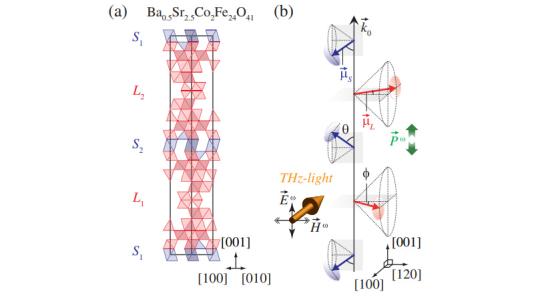
μ⃗S (blue arrow) and μ⃗L (red arrow). Blue and red ellipsoids represent trajectories of the moment modulations. θ and ϕ refer to the angles of μ⃗S from [001] and μ⃗L from [120], respectively.
Scientific Achievement
Using single crystals of a carbon dioxide Z‑type hexaferrite, we identified and modeled a time-domain terahertz (THz) electromagnon emerging in coincidence with transverse conical magnetic order.
Significance and Impact
Our work provides both an experimental realization as well as a mechanism and quantitative model of the dynamical magnetoelectric effect in a large class of multiferroics, delivering a potential materials platform for THz devices operating at room temperature.
Research Details
- Anisotropy of dielectric susceptibility accessible in single crystals allows unambiguous assignment of the electromagnon as coupling to transverse conical magnetic order.
-
Quantitative treatment of the magnetic field-dependence of the electromagnon resonance frequency developed based on the Dzyaloshinskii-Moriya interaction as the underlying mechanism for magnetochromism.
Argonne National Laboratory seeks solutions to pressing national problems in science and technology. The nation’s first national laboratory, Argonne conducts leading-edge basic and applied scientific research in virtually every scientific discipline. Argonne researchers work closely with researchers from hundreds of companies, universities, and federal, state and municipal agencies to help them solve their specific problems, advance America’s scientific leadership and prepare the nation for a better future. With employees from more than 60 nations, Argonne is managed by UChicago Argonne, LLC for the U.S. Department of Energy’s Office of Science.
The U.S. Department of Energy’s Office of Science is the single largest supporter of basic research in the physical sciences in the United States and is working to address some of the most pressing challenges of our time. For more information, visit https://energy.gov/science.